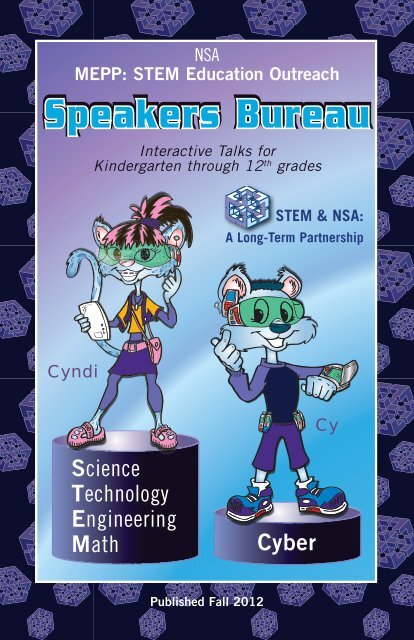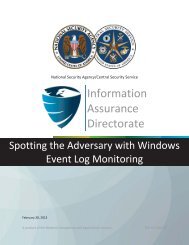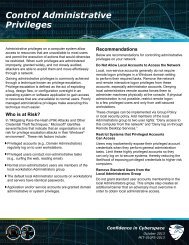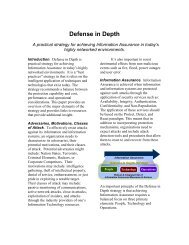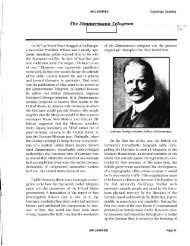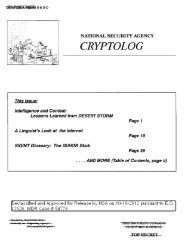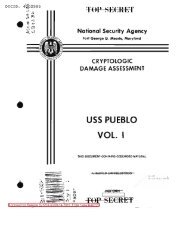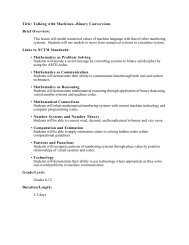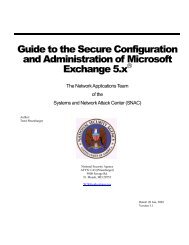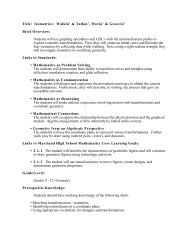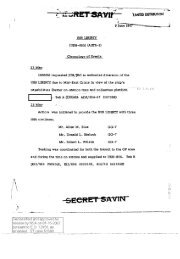Speakers Bureau Speakers Bureau - National Security Agency
Speakers Bureau Speakers Bureau - National Security Agency
Speakers Bureau Speakers Bureau - National Security Agency
You also want an ePaper? Increase the reach of your titles
YUMPU automatically turns print PDFs into web optimized ePapers that Google loves.
NSA<br />
MEPP: STEM Education Outreach<br />
<strong>Speakers</strong> <strong>Bureau</strong><br />
Interactive Talks for<br />
Kindergarten through 12 th grades<br />
STEM & NSA:<br />
A Long-Term Partnership<br />
Cyndi<br />
Cy<br />
Science<br />
Technology<br />
Engineering<br />
Math<br />
Cyber<br />
Published Fall 2012
SAVE ME<br />
Catalog published every other year.<br />
Save me to request talks for the next school year!
<strong>National</strong> <strong>Security</strong> <strong>Agency</strong><br />
MEPP <strong>Speakers</strong> <strong>Bureau</strong><br />
The <strong>National</strong> <strong>Security</strong> <strong>Agency</strong> (NSA) is the largest employer<br />
of mathematicians in the nation and, therefore, is critically<br />
dependent on the continuing development of first-class American<br />
mathematicians. Further, NSA has a strong technical work force in<br />
engineering, computers, networking and telecommunications, all<br />
of which require a sound foundation in mathematics. In response<br />
to concerns about a decline in the health of Science, Technology,<br />
Engineering and Mathematics (STEM) education in the United<br />
States, NSA has initiated several programs to support the STEM<br />
education reform effort at the local, state, and national levels. One<br />
of these programs is the MEPP <strong>Speakers</strong> <strong>Bureau</strong> which provides<br />
talks to local schools by NSA professionals.<br />
The MEPP <strong>Speakers</strong> <strong>Bureau</strong> offers a large variety of fun and<br />
fascinating STEM-related talks given by NSA employees to<br />
elementary, middle or high school students. Many talks include<br />
interactive activities to engage the students and have them<br />
actively involved during the visit. NSA hopes that the speakers’<br />
knowledge of and excitement about STEM topics will inspire<br />
students to be more enthusiastic about their future encounters<br />
with any of these subject areas.<br />
This program is only available to schools located in the<br />
Baltimore-Washington area due to the proximity of these schools<br />
to NSA, Ft. Meade.<br />
MEPP – STEM Education Outreach<br />
Published Fall 2012<br />
iii
Meet the CryptoKids! r<br />
r<br />
r<br />
Meet the CryptoKids gang and get to know all about our hobbies,<br />
interests, and favorite classes.<br />
Make your own secret codes and ciphers so that you can send<br />
secret messages to your friends.<br />
Learn how to say hello in different languages and the art of<br />
Morse code.<br />
Test your skills with fun games and activities.<br />
Learn how you can work for NSA by visiting our student<br />
resources section.<br />
Hang out with us on the web at www.nsa.gov/kids.<br />
iv<br />
MEPP – STEM Education Outreach
TABLE OF CONTENTS<br />
Requesting a Speaker ...................................................1<br />
Section I: Talks for Elementary School ....................4<br />
Section II: Talks for Middle School .........................12<br />
Section III: Talks for High School ...........................19<br />
Section IV: Cyber <strong>Security</strong> and On-line Safety ...... 25<br />
Section V: Other Resources .......................................26<br />
Index/Notes ................................................................ 27<br />
Recommended Grade Levels .....................................31<br />
Socket<br />
nsa.gov/kids<br />
MEPP – STEM Education Outreach<br />
v
Cyndi<br />
Cy<br />
vi<br />
MEPP – STEM Education Outreach
Requesting a Speaker<br />
If you are interested in requesting a speaker, please email<br />
mepp@nsa.gov with the subject line of “:<br />
MEPP <strong>Speakers</strong> <strong>Bureau</strong>” and the following information:<br />
School Name:<br />
School Address:<br />
City:<br />
County:<br />
State:<br />
Zip:<br />
Teacher Name:<br />
Work Phone:<br />
Email:<br />
Fax:<br />
Other contact number:<br />
Talk Requested: (please list title from catalog of topics):<br />
1st Choice:<br />
2nd Choice:<br />
3rd Choice:<br />
Grade:<br />
Number of Homerooms:<br />
Approximate number of students per homeroom:<br />
Comments:<br />
If you prefer, a copy of the form may be downloaded from the website<br />
at: http://www.nsa.gov/academia/early_opportunities/math_edu_<br />
partnership/index.shtml.<br />
This page also links to an on-line version of this catalog. After<br />
completing the form, please fax or mail to:<br />
<strong>National</strong> <strong>Security</strong> <strong>Agency</strong><br />
MEPP <strong>Speakers</strong> <strong>Bureau</strong><br />
ATTN: MEPP / Suite 6637<br />
Ft. Meade, MD 20755-6637<br />
E-mail: mepp@nsa.gov<br />
Fax: 443-479-1193<br />
Phone: 301-688-6214<br />
MEPP – STEM Education Outreach 1
Additional Talk Request Information<br />
Requests cannot be taken over the telephone. However, if you have<br />
any questions, please feel free to call us on the number listed above.<br />
Many of the talks are interactive and, therefore, work better if<br />
the audience is small. Note that “appropriate grade levels” and<br />
“minimum time needed” are specified for each talk. Please use this<br />
information to guide you during talk selection and scheduling.<br />
To better meet the needs of all schools, we limit each class at any<br />
school to one speaker per academic year. Please provide first, second,<br />
and third choice topics for each request to improve our ability to<br />
serve you.<br />
Speaker Availability<br />
Once a speaker has volunteered to visit your school, that speaker<br />
will then contact you to arrange a mutually convenient date and time<br />
to visit your classroom. To assist in this process, please be sure to<br />
include complete contact information. The more flexible you are,<br />
the better we can serve your needs! We will honor requests as our<br />
resources permit.<br />
Please understand that all our speakers are mathematicians,<br />
computer scientists, engineers, cryptanalysts, and other NSA<br />
professionals who speak in the schools in addition to their normal<br />
duties. Speaker availability varies.<br />
The talk must be scheduled during a time that the regular teacher,<br />
and not a substitute, will be present in the classroom; and the teacher<br />
must remain in the classroom for the entire presentation. At no time<br />
are NSA speakers to be left alone in the classroom. NSA <strong>Speakers</strong> are<br />
not responsible for classroom discipline and cannot accept liability<br />
for the students.<br />
A speaker evaluation form is available online at http://www.nsa.gov/<br />
academia/early_opportunities/math_edu_partnership/index.shtml.<br />
After your talk, please make a copy of this form and send it back to<br />
us with your comments.<br />
THERE IS NO CHARGE FOR THESE TALKS.<br />
2 MEPP – STEM Education Outreach
Educational Partnership Agreements<br />
Educational Partnership Agreements (EPAs) are required<br />
between NSA and the school receiving MEPP talks. This is a very<br />
straightforward document to outline the responsibilities of the<br />
school and NSA, and is valid for 3 years. Our office will work with<br />
your school to establish one prior to the speaker visit if an EPA does<br />
not currently exist.<br />
Additional MEPP Services<br />
School Partnerships: NSA MEPP Partners develop continuing<br />
relationships with schools, spending part of their work week to<br />
provide tutoring or enrichment activities in Science, Technology,<br />
Engineering and Mathematics.<br />
Science/STEM Fair Judges: NSA provides judges to local K-12<br />
math, science and STEM fairs and competitions.<br />
MEPP Competitive Grants: The MEPP office has limited funds<br />
available for grants and cooperative agreements that promote<br />
the study of STEM subjects, and provide training opportunities<br />
for teachers.<br />
There is no charge for any of these MEPP services. As previously<br />
stated, all our MEPP participants are NSA professionals who<br />
participate with local schools in addition to their normal duties.<br />
While the MEPP office will attempt to fill your request from the<br />
pool of MEPP participants, it cannot be guaranteed as personnel<br />
availability varies. For further information on any of the above<br />
MEPP services, please contact the MEPP office at email: mepp@<br />
nsa.gov or phone (301) 688-6214.<br />
MEPP – STEM Education Outreach 3
Section I: Talks for Elementary School<br />
Adventures in Countable County<br />
(Appropriate for grades K-2; minimum time needed is 45 minutes)<br />
This adventure is geared toward familiarizing students with<br />
mathematical terminology, fostering logical thinking, and<br />
demonstrating the usefulness of mathematics. This includes working<br />
with the names of numbers, basic geometric shapes, telling time,<br />
counting, and measuring.<br />
Bubble Sorting<br />
(Appropriate for grades K-2; minimum time needed is 30 minutes)<br />
In this talk the students simulate a simple sorting algorithm<br />
by acting as components of a computer. N+6 children are needed,<br />
where N is the number of children to be sorted (N=4 or 5 is a good<br />
sort length). The N children to be sorted sit in memory and the<br />
remaining 6 children residing in the CPU are assigned jobs such<br />
as fetch, store, and swap. Concepts covered include computer<br />
architecture, algorithm, order, bubble sort, address, pointer and<br />
compare. Additional topics that could be discussed are other sorting<br />
algorithms, sort fields, complexity, efficiency, ties, time/memory<br />
trade-off, other computer algorithms, and class development of<br />
an algorithm.<br />
Buried Treasure<br />
(Appropriate for grades 3-5; minimum time needed is 45 minutes)<br />
This is a wonderful introduction to cryptology! Based on the theme<br />
of a popular cartoon, students will be asked to decode directions<br />
and follow a buried treasure map in order to find the treasure.<br />
But Who’s Counting?<br />
(Appropriate for grades 2-5; minimum time needed is 45 minutes)<br />
Students play a game to create numbers based on the results of a<br />
spin of the wheel! A very versatile talk which may be used to reinforce<br />
a number of mathematic concepts. Students spin a wheel which has<br />
digits between 0 and 9, and then are challenged to create specific<br />
numbers, such as the lowest, five-digit number. Other variations<br />
of this game include the class as a whole building a number that<br />
satisfies a math property given by the NSA Speaker (such as largest<br />
odd number) or the class constructing addition or multiplication<br />
4 MEPP – STEM Education Outreach
problems whose answer satisfies a math property given by the NSA<br />
Speaker. This game can also include an introduction to probability.<br />
Careers at NSA<br />
(Appropriate for grades 1-5; minimum time needed is 30 minutes)<br />
Is your school having a career day? Students are introduced to the<br />
variety of careers at NSA, emphasizing the technical skills of the<br />
workforce and inviting the students to consider activities they like to<br />
do now, and how this may fit in to a future career. Alternatively, some<br />
talks may be adapted to fit into this time frame, such as Cryptanalysis<br />
101, Mathematical Ways of Thinking, and Sir Cumference Math<br />
Adventures. Please let us know if you would like the Careers at NSA<br />
talk, or whether you would prefer an adapted talk.<br />
Cryptanalysis 101<br />
(Appropriate for grades 4-5; minimum time needed is 45 minutes)<br />
This presentation defines the basic terminology used in code<br />
breaking. It then introduces a variety of elementary ciphers. Students<br />
are led through the deciphering of several messages using various<br />
substitution and transposition ciphers. The frequencies of letters<br />
in English are discussed. For more advanced classes, a message<br />
in English is deciphered by using frequency counts. Background<br />
material and additional problems are given as handouts.<br />
Exclamation Explanation!<br />
(Appropriate for grades 4-5; minimum time needed is 45 minutes)<br />
This talk is designed to take your students through the process<br />
of developing (and understanding) the mathematical concept of<br />
factorials one step at a time, by recognizing patterns, extending<br />
their thinking, and just having some fun. This talk is best for<br />
students who have never seen factorial numbers before.<br />
Experimenting With Chance<br />
(Appropriate for grades 4-5; minimum time needed is 45 minutes)<br />
This talk introduces students to the concept of probability by<br />
exploring the scientific method. The ideas of testing hypotheses,<br />
collecting data by simulation, and empirical probability will<br />
be emphasized. As time permits, pairs of students will perform<br />
MEPP – STEM Education Outreach 5
statistical experiments to test their hypotheses regarding the<br />
results of: (1) tossing a coin; (2) rolling a single die; (3) rolling a<br />
pair of dice and taking the sum of the two faces; or (4) rolling a<br />
10-sided die. Relevant worksheets and charts will be provided to<br />
the students. If time permits, students will draw the bar graphs or<br />
histograms that depict the probability distribution of the outcomes<br />
of these experiments.<br />
Fun With Geometry<br />
(Appropriate for grades 4-5; minimum time needed is 45 minutes)<br />
Students learn, by participating at their desks, how to quickly<br />
construct triangles, squares, hexagons (or stars) and octagons<br />
using only a compass and a straight edge. If time permits, the<br />
exercise can be extended to dividing a circle into twelve parts<br />
and drawing chords inside it with colored pencils, thus creating a<br />
kaleidoscopic effort.<br />
Gold Bug<br />
(Appropriate for grades 4-5; minimum time needed is 60 minutes)<br />
Edgar Allen Poe’s “The Gold Bug” is a fascinating story of pirates<br />
and buried treasure. Poe tells about a slightly eccentric man who<br />
deciphers a secret message to find some of Captain Kidd’s hidden<br />
treasure. The students will hear a summary of “The Gold Bug” story<br />
and will learn the problem-solving skills needed to break the code.<br />
By working together and with the instructor, the students will solve<br />
this puzzle with a logical, step-by-step attack using simple statistics.<br />
Graph Theory Every Day<br />
(Appropriate for grades 3-5; minimum time needed is 45 minutes)<br />
This talk introduces basic concepts of graph theory and<br />
optimization through examples that might include placing police<br />
officers on the grid of a neighborhood or finding the shortest path<br />
between two locations. Emphasis will be placed on ways that we<br />
already use these concepts in everyday life.<br />
Likenesses and Differences<br />
(Appropriate for grades K - early 1 only; minimum time needed is 30<br />
minutes)<br />
A domino-like game is played using large cards with pictures of shapes in<br />
differing sizes in order to explore the concept of likenesses and differences.<br />
6 MEPP – STEM Education Outreach
M-A-T-H…It’s Not Just Another Four-Letter Word!<br />
(Appropriate for grades 4-5; minimum time needed is 45 minutes)<br />
This talk is aimed at lower-level math students and students who<br />
think that math is not fun. The students participate in activities<br />
involving a television show and solving a mystery surrounding the<br />
show. The focus is not on arithmetic but on problem solving and<br />
decision making.<br />
Mathematical Ways of Thinking<br />
(Appropriate for grades 3-5; minimum time needed is 45 minutes)<br />
Students are challenged to ‘think outside of the box’ by applying<br />
logic and reasoning to a variety of games and puzzles.<br />
Mission Possible<br />
(Appropriate for grade 5; minimum time needed is 60 minutes)<br />
Your mission, should you choose to accept it, is to recover<br />
the secret code which holds the key to this briefcase… During<br />
this session, the class will join “the <strong>Agency</strong>,” an elite group<br />
of cryptanalysts and problem solvers. They will be trained on<br />
two basic topics of cryptography and the elementary statistical<br />
properties demonstrated by each. They will then be divided into<br />
teams. Each team will have an encrypted message in which they<br />
must diagnose the type of cryptography used and then decipher<br />
using the appropriate cryptanalysis techniques. The success of<br />
“the <strong>Agency</strong>” depends upon all teams solving their messages and<br />
then working together on one final problem to recover the secret<br />
code to the briefcase. This interactive session presents basic<br />
cryptanalytic concepts and focuses on problem-solving techniques<br />
with a lot of teamwork.<br />
One Dollar Shirt<br />
(Appropriate for grades 3-4; minimum time needed is 45 minutes)<br />
The lesson provides a general review of geometric shapes: point,<br />
line, rectangle, triangle, circle, and oval. After describing these<br />
basic geometric shapes, a fun exercise is presented to show how<br />
these shapes can be used in paper folding (Origami) using a dollar<br />
bill to create a small shirt. The students can bring in their own crisp<br />
one dollar bill, or we will supply play money.<br />
MEPP – STEM Education Outreach 7
Pascal’s Triangle<br />
(Appropriate for grades 4-5; minimum time needed is 50 minutes)<br />
Blaise Pascal was a renowned 17th Century French scientist<br />
and mathematician. One of his most important discoveries was a<br />
collection of integers arranged in a triangular fashion which can<br />
easily be computed using only simple addition. Today, we call this<br />
construction Pascal’s Triangle. During the class, the speaker will<br />
guide the students through the generation of Pascal’s Triangle and<br />
then investigate some of the marvelous mathematical properties of<br />
Pascal’s Triangle. Applications covered in class will vary according<br />
to the level and ability of the class and include: elementary<br />
probability, binary arithmetic, sequences and patterns.<br />
Patterns and Number Sequences<br />
(Appropriate for grades 4-5; minimum time needed is 60 minutes)<br />
Students will be introduced to patterns by examining various<br />
arithmetic sequences. The students will determine the “rule” for<br />
generating each sequence. Non-arithmetic sequences will also<br />
be used. Students will then learn about properties of the English<br />
language, such as expected letter frequencies, in order to combine<br />
this knowledge with their pattern-identifying skills to decrypt a<br />
secret message.<br />
Polls, Probability and You<br />
(Appropriate for grades 3-5; minimum time needed is 45 minutes)<br />
This talk introduces students to the concept of probability<br />
through the vehicle of a statistical survey. Appealing to the natural<br />
curiosities of students about themselves, the speaker will conduct<br />
a poll to determine prominent attributes and marked preferences<br />
of the class. Students are then given the opportunity to reveal their<br />
class profile using worksheets to answer pertinent probability<br />
questions. Venn diagrams will be used to assist students in their<br />
assessment of both conditional and unconditional probabilities.<br />
At least two examples of Venn diagrams will be used with two<br />
sets of student characteristics, such as the set of all left-handed<br />
students and the set of all girls in the class. Depending on the level<br />
of the class, a Venn diagram with three sets will be constructed<br />
and analyzed.<br />
8 MEPP – STEM Education Outreach
Science Fair Projects – A Judge’s Perspective<br />
(Appropriate for grades 3-5; minimum time needed is 45 minutes)<br />
Over the past years, NSA has provided science fair judges to<br />
numerous science fairs in the Baltimore-Washington area. These<br />
science fairs have ranged from non-competitive elementary<br />
school to highly competitive regional high school fairs. This talk<br />
is a compilation of our observations and is intended for both the<br />
student and teacher alike. It covers the major steps in the scientific<br />
method (problem statement, hypothesis, materials, testing/<br />
procedure, analysis, conclusion), and focuses on experiment versus<br />
demonstration, repeated trials/stratified testing, presentation and<br />
the interview.<br />
Sir Cumference Math Adventures<br />
(Appropriate for grades K-2; minimum time needed is 30 minutes)<br />
These are interactive presentations based on the illustrated<br />
children’s books by the same names. They are designed to be fun<br />
while teaching mathematical ideas such as geometry, measurement,<br />
angles, shapes, solids, problem solving and mathematical reasoning.<br />
Available stories are:<br />
Sir Cumference and the First Round Table<br />
King Arthur has a problem! He needs the perfect table to<br />
accommodate him and his knights. Assisted by his knight, Sir<br />
Cumference, and using ideas offered by the knight’s wife Lady<br />
Di of Ameter, and son Radius, together they discover the perfect<br />
shape for the king’s table.<br />
Sir Cumference and the Dragon of Pi<br />
Sir Cumference, Lady Di of Ameter, and Radius are back in their<br />
second Math Adventure! This time, a potion has accidentally<br />
changed Sir Cumference into a fire-breathing dragon. Can<br />
Radius change him back in time? Join Radius on his quest<br />
through the castle to solve a riddle that will reveal the cure.<br />
It lies in discovering the magic number that is the same for all<br />
circles.<br />
Sir Cumference and the Great Knight of Angleland<br />
An adventure by degrees!! Radius, son of Sir Cumference and<br />
Lady Di of Ameter, wants to be a knight more than anything.<br />
MEPP – STEM Education Outreach 9
To earn his knighthood, he needs to venture alone on a heroic<br />
quest. With only an ancient family medallion (a protractor) for<br />
luck, Radius dodges dangers and dragons to find their neighbor,<br />
King Lell, who has disappeared. The ultimate challenge lies in<br />
a mysterious castle with a maze of many angles.<br />
Sir Cumference and the Sword in the Cone<br />
King Arthur has hidden his sword, Edgecalibur. The knight<br />
who finds it will be the next king. Sir Cumference and Lady Di<br />
try to help point Vertex in the right direction. Vertex enlists<br />
the aid of the carpenters Geo and Sym of Metry in creating<br />
three-dimensional shapes from two-dimensional outlines. Will<br />
Vertex’s sharp thinking give him the edge?<br />
Skittles Guessing Game<br />
(Appropriate for grades 1-4; minimum time needed is 50 minutes)<br />
This talk introduces students to the important concept of<br />
estimation by exploring the scientific method. Every student is<br />
given a fun-size bag of Skittles candies (data) from which they are<br />
asked to estimate: (1) the total number of candies in the bag; (2)<br />
the most commonly occurring color in the bag; and (3) the numbers<br />
of each of the six colors occurring in the bag. After each student<br />
has made his/her “guesses,” the real fun begins. Every student is<br />
asked to open his/her bag of Skittles to gather and analyze the data,<br />
then form conclusions. All necessary worksheets and candies will<br />
be provided to the students.<br />
Solving Sudoku<br />
(Appropriate for grade 4; minimum time needed is 60 minutes)<br />
Sudoku is a Japanese word meaning “single digits only” and<br />
today is used to identify a form of logic puzzle using nine elements.<br />
Puzzle creators use numbers, symbols, letters, shapes, colors, etc.<br />
or any combination of these to differentiate between the elements.<br />
In this talk, the students will be introduced to the types of logic/<br />
problem-solving skills they will need to use in order to complete<br />
the series of beginner-level Sudoku puzzles at the end of this talk.<br />
10 MEPP – STEM Education Outreach
Strega Nona<br />
(Appropriate for grades 1-3; minimum time needed is 45 minutes.<br />
Patterns is appropriate for grades 1-2. Time is appropriate for advanced<br />
2nd graders and 3rd grade. Money is appropriate for 3rd grade.)<br />
“Strega Nona,” a children’s book written by Tomie de Paola,<br />
tells the story of Strega Nona, or “grandmother witch,” and Big<br />
Anthony, her hired hand. When Big Anthony doesn’t pay attention<br />
and interferes with Strega Nona’s magic pasta pot, he learns a very<br />
big lesson. Three different mathematical activities are available<br />
to students for this presentation with the areas of emphasis being<br />
patterns, time or money. When selecting this topic, please indicate<br />
your preferred activity (patterns, time, or money).<br />
Taking Polls and Making Faces<br />
(Appropriate for grades K - early 1; minimum time needed is 30<br />
minutes)<br />
Students will answer age-appropriate questions and will match<br />
their answers to geometric shapes. The students then draw the<br />
geometric shapes on paper plates to create faces, and compare faces<br />
to see how much they are alike and different from each other.<br />
Total Integer Workout<br />
(Appropriate for grades 3-4; minimum time needed is 45 minutes)<br />
This presentation reinforces addition, subtraction, multiplication,<br />
and division skills. It will also show associative and commutative<br />
properties while encouraging independent, creative problem<br />
solving. Given a set of numbers between 1 and 9, the students will<br />
be asked to “build” another specified number between 1 and 9 using<br />
the basic arithmetic operations.<br />
MEPP – STEM Education Outreach 11
Section II: Talks for Middle School<br />
Careers at NSA<br />
(Appropriate for grades 6-8; minimum time needed is 30 minutes)<br />
Is your school having a career day? Students are introduced to<br />
the variety of careers at NSA, emphasizing the technical skills of<br />
the workforce. NSA also has a range of student programs to enable<br />
students to gain practical experience before graduating high school<br />
or college. In addition, for Career Days some talks may be adapted<br />
to fit into this time frame, such as Cryptanalysis 101, Cyber Ethics,<br />
Mathematical Ways of Thinking, and STEM and Life-long Learning.<br />
Please let us know if you would like the Careers at NSA talk, or<br />
whether you would prefer an adapted talk.<br />
Coding Theory in Your Mailbox<br />
(Appropriate for grades 6-8; minimum time needed is 45 minutes)<br />
Do you ever wonder what those lines are for on the bottom of<br />
business reply postcards? This talk lets students answer this<br />
question in a hands-on manner, and, time permitting, shows other<br />
applications of “check digits” in the modern world. In more advanced<br />
classes, students can investigate questions such as, “What types of<br />
errors will such checking catch?”<br />
Cryptanalysis 101<br />
(Appropriate for grades 6-8; minimum time needed is 45 minutes)<br />
This presentation defines the basic terminology used in code<br />
breaking. It then introduces a variety of elementary ciphers. Students<br />
are led through the deciphering of several messages using various<br />
substitution and transposition ciphers. The frequencies of letters<br />
in English are discussed. For more advanced classes, a message<br />
in English is deciphered by using frequency counts. Background<br />
material and additional problems are given as handouts.<br />
Cryptoball<br />
(Appropriate for grades 6-8; minimum time needed is 60 minutes)<br />
Students are first introduced to various encryption methods, such as<br />
Caesar substitution, by encoding and decoding select messages. The<br />
students then play an indoor football-like game in which the offensive<br />
team creates a secret code to designate which player will receive the<br />
pass. The defense tries to break the code to intercept the ball.<br />
12 MEPP – STEM Education Outreach
Cryptology: Past and Present<br />
(Appropriate for grade 8; minimum time needed is 50 minutes)<br />
This talk will cover the basics of cryptography. Basic terminology,<br />
historical information, and current topics will be discussed and<br />
illustrated with slides, including: (1) Simple substitution – Caesar<br />
cipher, cipher disk (Italy 1470, Civil War, WWI), Vigenere square<br />
(1586); (2) Simple transposition; (3) Combination of substitution and<br />
transposition; (4) The Enigma (WWII German cipher device); (5)<br />
Data Encryption Standard; and (6) public key cryptography.<br />
Cyber Ethics<br />
(Appropriate for grades 6-8; minimum time needed is 45 minutes)<br />
Cyber ethics refers to a code of safe and responsible behavior<br />
for the Internet community. Practicing good cyber ethics involves<br />
understanding the risks of harmful and illegal behavior on-line. The<br />
information presented will help students understand the ethical<br />
issues as related to computers. Terms will be introduced and cases<br />
will be presented to help the students understand the material.<br />
Topics that will be presented include: (1) Computers and Privacy;<br />
(2) Crime, Abuse, and Hacker Ethics; (3) Responsibility; and (4)<br />
Social Implications and Consequences. The students will leave with<br />
simple guidelines on how to make an ethical decision and the Ten<br />
Commandments of Computer Ethics.<br />
Defending Our Nation in Cyberspace<br />
(Appropriate for grade 8; minimum time needed is 45 minutes)<br />
How are you protecting yourself from thieves in Cyberspace? How<br />
are we as a nation and country protecting ourselves from threats<br />
in Cyberspace? If you combine protection and defense this defines<br />
itself as Cyber<strong>Security</strong>. This unique presentation provides a view<br />
of cybersecurity and its threats such as infected websites, infected<br />
emails, phishing attacks and social engineering from a national<br />
level down to the home user, and presents how it takes a team to<br />
make Cyberspace more secure. The talk provides “homework time”<br />
on how to secure your home computer via a variety of “tasks.”<br />
MEPP – STEM Education Outreach 13
Defense Against the Dark Arts – Cyber <strong>Security</strong> Basics<br />
(Appropriate for grades 6-8; minimum time needed 45 minutes)<br />
Just as young wizards in the Hogwarts Academy must learn about<br />
dark magic and dark creatures to defend themselves, so must young<br />
cyber wizards learn about malware and hackers. Topics covered<br />
include viruses, worms, Trojan horses, identify theft, phishing and<br />
social engineering.<br />
Experimenting With Chance<br />
(Appropriate for grades 6-8; minimum time needed is 45 minutes)<br />
This talk introduces students to the concept of probability by<br />
exploring the scientific method. The ideas of testing hypotheses,<br />
collecting data by simulation, and empirical probability will<br />
be emphasized. As time permits, pairs of students will perform<br />
statistical experiments to test their hypotheses regarding the<br />
results of: (1) tossing a coin; (2) rolling a single die; (3) rolling a<br />
pair of dice and taking the sum of the two faces; or (4) rolling a<br />
10-sided die. Relevant worksheets and charts will be provided to<br />
the students. If time permits, students will draw the bar graphs or<br />
histograms that depict the probability distribution of the outcomes<br />
of these experiments.<br />
Gold Bug<br />
(Appropriate for grades 6-8; minimum time needed is 60 minutes)<br />
Edgar Allen Poe’s “The Gold Bug” is a fascinating story of pirates<br />
and buried treasure. Poe tells about a slightly eccentric man who<br />
deciphers a secret message to find some of Captain Kidd’s hidden<br />
treasure. The students will hear a summary of “The Gold Bug” story<br />
and will learn the problem-solving skills needed to break the code.<br />
By working together and with the instructor, the students will solve<br />
this puzzle with a logical, step-by-step attack using simple statistics.<br />
How to Lie With Statistics<br />
(Appropriate for grades 6-8; minimum time needed is 45 minutes)<br />
The study of statistics is mathematically rigorous, but the statistics<br />
themselves can be used, often incorrectly, in non-mathematical<br />
ways. TV advertisers do not usually falsify statistics – they can be<br />
sued or fined for that. However, they still mislead us with statistics<br />
14 MEPP – STEM Education Outreach
that are taken out of context, that are based on too small a sample<br />
size or on a biased sample, or that are based on biased questions or<br />
words with no generally agreed-upon meaning. For example, Bayer<br />
Aspirin asked 100 doctors, if they were stranded on a desert island,<br />
would they rather have aspirin or Tylenol? More doctors chose<br />
aspirin. But the advertisement does not tell you why. Aspirin is also<br />
an anti-inflammatory drug. This does not mean that aspirin would<br />
be their drug of choice for a headache at work. The statistic may be<br />
true, but the question on which it is based is misleading. Consumers<br />
must be aware of how statistics can be misused in order to avoid<br />
being taken in by others. This talk will illustrate how this is done.<br />
Keeping your Desktop and Laptop Secure<br />
(Appropriate for grades 7-8; minimum time needed is 45 minutes)<br />
The cyber threat is no longer limited to Governments and Large<br />
Corporations--You are a target. Cyber thugs realize that people<br />
operating from home are more vulnerable because there is much<br />
less structure associated with protection and maintenance of most<br />
home networks. Home users need to maintain at least a basic level<br />
of network defense for themselves and their family members when<br />
accessing the Internet. This talk will provide an introduction to<br />
these basics, and build an awareness of cyber threats.<br />
Logic<br />
(Appropriate for grades 6-8; minimum time needed is 45 minutes)<br />
This talk presents an introduction to logic and mathematical<br />
reasoning. All students participate in solving logic puzzles and<br />
in identifying unstated yet mathematical true statements. The<br />
principles discussed will be reinforced by presenting concepts<br />
such as Venn diagrams, syllogisms, and advertisements from<br />
current magazines.<br />
M-A-T-H…It’s Not Just Another Four-Letter Word!<br />
(Appropriate for grade 6; minimum time needed is 45 minutes)<br />
This talk is aimed at lower-level math students and students who<br />
think that math is not fun. Students participate in activities involving<br />
television and solving a mystery. The focus is not on arithmetic, but<br />
on problem solving and decision making.<br />
MEPP – STEM Education Outreach 15
Mathematical Ways of Thinking<br />
(Appropriate for grades 6-8; minimum time needed is 45 minutes)<br />
Students are challenged to ‘think outside of the box’ by applying<br />
logic and reasoning to a variety of games and puzzles.<br />
Mission Possible<br />
(Appropriate for grades 6-8; minimum time needed is 60 minutes)<br />
Your mission, should you choose to accept it, is to recover<br />
the secret code which holds the key to this briefcase… During<br />
this session, the class will join “the <strong>Agency</strong>,” an elite group of<br />
cryptanalysts and problem solvers. They will be trained on two<br />
basic topics of cryptography and the elementary statistical<br />
properties demonstrated by each. They will then be divided into<br />
teams. Each team will have an encrypted message in which they<br />
must diagnose the type of cryptography used and then decipher<br />
using the appropriate cryptanalysis techniques. The success of<br />
“the <strong>Agency</strong>” depends upon all teams solving their messages and<br />
then working together on one final problem to recover the secret<br />
code to the briefcase. This interactive session presents basic<br />
cryptanalytic concepts and focuses on problem-solving techniques<br />
with a lot of teamwork.<br />
Pascal’s Triangle<br />
(Appropriate for grades 6-8; minimum time needed is 50 minutes)<br />
Blaise Pascal was a renowned 17 th Century French scientist<br />
and mathematician. One of his most important discoveries was a<br />
collection of integers arranged in a triangular fashion which can<br />
easily be computed using only simple addition. Today, we call this<br />
construction Pascal’s Triangle. During the class, the speaker will<br />
guide the students through the generation of Pascal’s Triangle and<br />
then investigate some of the marvelous mathematical properties of<br />
Pascal’s Triangle. Applications covered in class will vary according<br />
to the level and ability of the class and include: elementary<br />
probability, binary arithmetic, sequences and patterns.<br />
Patterns and Number Sequences<br />
(Appropriate for grades 6-8; minimum time needed is 60 minutes)<br />
Students will be introduced to patterns by examining various<br />
arithmetic sequences. The students will determine the “rule” for<br />
16 MEPP – STEM Education Outreach
generating each sequence. Non-arithmetic sequences will also<br />
be used. Students will then learn about properties of the English<br />
language, such as expected letter frequencies, in order to combine<br />
this knowledge with their pattern-identifying skills to decrypt a<br />
secret message.<br />
Polls, Probability and You<br />
(Appropriate for grade 6; minimum time needed is 45 minutes)<br />
This talk introduces students to the concept of probability<br />
through the vehicle of a statistical survey. Appealing to the<br />
natural curiosities of students about themselves, the speaker will<br />
conduct a poll to determine prominent attributes and marked<br />
preferences of the class. Students are then given the opportunity<br />
to reveal their class profile using worksheets to answer pertinent<br />
probability questions. Venn diagrams will be used to assist<br />
students in their assessment of both conditional and unconditional<br />
probabilities. At least two examples of Venn diagrams will be used<br />
with two sets of student characteristics, such as the set of all lefthanded<br />
students and the set of all girls in the class. Depending<br />
on the level of the class, a Venn diagram with three sets will be<br />
constructed and analyzed.<br />
Science Fair Projects – A Judge’s Perspective<br />
(Appropriate for grades 6-8; minimum time needed is 45 minutes)<br />
Over the past years, NSA has provided science fair judges to<br />
numerous science fairs in the Baltimore-Washington area. These<br />
science fairs have ranged from non-competitive elementary<br />
school to highly competitive regional high school fairs. This talk<br />
is a compilation of our observations and is intended for both the<br />
student and teacher alike. It covers the major steps in the scientific<br />
method (problem statement, hypothesis, materials, testing/<br />
procedure, analysis, conclusion), and focuses on experiment versus<br />
demonstration, repeated trials/stratified testing, presentation and<br />
the interview.<br />
Social Network Sites<br />
(Appropriate for grades 6-8; minimum time needed is 50 minutes)<br />
Every few years, a new technology or capability arises that<br />
intrigues and excites the public. Social Networking Sites (SNSs) are<br />
one such technology. In providing a place where people can easily<br />
MEPP – STEM Education Outreach 17
post their thoughts, photos, and connect with friends and family in<br />
spontaneous ways, SNSs have seen great popularity in recent years.<br />
However, there have been many stories highlighting the dangers<br />
of being too open and free with important personal or business<br />
information. Teenagers are prevalent users of SNSs; this talk will<br />
help teach them the risks and how to apply basic security principles<br />
to their on-line profiles to safeguard themselves.<br />
STEM and Life-Long Learning<br />
(Appropriate for grades 6-8; minimum time needed is 30 minutes)<br />
This presentation provides a framework for encouraging students<br />
to study in Science, Technology, Engineering, and Mathematics<br />
(STEM) subjects. Key points of the talk: technology is a major driver<br />
of innovation; students are encouraged to take advantage of any<br />
learning opportunities; technology is rapidly advancing, and that<br />
learning continues throughout your career. Appropriate for career<br />
day activities.<br />
Tessellations<br />
(Appropriate for grades 6-8; minimum time needed is 45 minutes)<br />
From architecture to textiles, tessellations are all around us. In<br />
this fun geometry talk, students discover how repeating patterns<br />
have been used around the world throughout history. There’s plenty<br />
of room for creativity as students learn the basic features of pattern<br />
design and create their own tessellations.<br />
Winning Games: Luck or Logic?<br />
(Appropriate for grades 6-8; minimum time needed is 45 minutes)<br />
This presentation introduces students to some of the basic<br />
concepts of game theory. By first discussing a simple game, then<br />
playing the game in pairs, fundamentals of picking strategies are<br />
demonstrated. After each game is played, the group discusses the<br />
strategies available and which ones worked the best.<br />
18 MEPP – STEM Education Outreach
Section III: Talks for High School<br />
Careers at NSA<br />
(Appropriate for grades 9-12; minimum time needed is 30 minutes)<br />
Is your school having a career day? Students are introduced to<br />
the variety of careers at NSA, emphasizing the technical skills of<br />
the workforce. NSA also has a range of student programs to enable<br />
students to gain practical experience before graduating high school<br />
or college. In addition, for Career Days some talks may be adapted<br />
to fit into this time frame, such as Elementary Cryptanalysis, Cyber<br />
Ethics, and STEM and Life-long Learning. Please let us know if you<br />
would like the Careers at NSA talk, or whether you would prefer an<br />
adapted talk.<br />
Coding Theory in Your Mailbox<br />
(Appropriate for grades 9-12; minimum time needed is 45 minutes)<br />
Do you ever wonder what those lines are for on the bottom of<br />
business reply postcards? This talk lets students answer this<br />
question in a hands-on manner, and, time permitting, shows other<br />
applications of “check digits” in the modern world. In more advanced<br />
classes, students can investigate questions such as, “What types of<br />
errors will such checking catch?”<br />
Cryptanalysis 101<br />
(Appropriate for grades 9-10; minimum time needed is 45 minutes)<br />
This presentation defines the basic terminology used in code<br />
breaking. It then introduces a variety of elementary ciphers. Students<br />
are led through the deciphering of several messages using various<br />
substitution and transposition ciphers. The frequencies of letters<br />
in English are discussed. For more advanced classes, a message<br />
in English is deciphered by using frequency counts. Background<br />
material and additional problems are given as handouts.<br />
Cryptoball<br />
(Appropriate for grades 9-10; minimum time needed is 60 minutes)<br />
Students are first introduced to various encryption methods,<br />
such as Caesar substitution, by encoding and decoding select<br />
messages. The students then play an indoor football-like game in<br />
which the offensive team creates a secret code to designate which<br />
player will receive the pass. The defense tries to break the code to<br />
intercept the ball.<br />
MEPP – STEM Education Outreach 19
Cryptography and Cryptanalysis<br />
(Appropriate for grades 9-12; minimum time needed is 60 minutes)<br />
This talk will introduce students to the art of making and breaking<br />
codes/ciphers. For the cryptography portion of the talk, symmetric<br />
vs. asymmetric (traditional vs. public key) cryptography, keys and<br />
basic security services (confidentiality, integrity, authentication,<br />
nonrepudiation, and availability) will be discussed. Applications<br />
and use of cryptography for the government and private sector will<br />
also be discussed. For the cryptanalysis portion of the talk, codes<br />
vs. ciphers will be discussed; examples of public codes (UPC, Morse,<br />
sign language) will be shown. The students will be introduced<br />
to transposition and substitution encipherment/decipherment<br />
through brief examples and will have an opportunity to decipher<br />
a cryptogram.<br />
Cryptology: Past and Present<br />
(Appropriate for grades 9-12; minimum time needed is 50 minutes)<br />
This talk will cover the basics of cryptography. Basic terminology,<br />
historical information, and current topics will be discussed and<br />
illustrated with slides, including: (1) Simple substitution – Caesar<br />
cipher, cipher disk (Italy 1470, Civil War, WWI), Vigenere square<br />
(1586); (2) Simple transposition; (3) Combination of substitution and<br />
transposition; (4) The Enigma (WWII German cipher device); (5)<br />
Data Encryption Standard; and (6) public key cryptography.<br />
Cyber Ethics<br />
(Appropriate for grades 9-12; minimum time needed is 45 minutes)<br />
Cyber ethics refers to a code of safe and responsible behavior<br />
for the Internet community. Practicing good cyber ethics involves<br />
understanding the risks of harmful and illegal behavior on-line. The<br />
information presented will help students understand the ethical<br />
issues as related to computers. Terms will be introduced and cases<br />
will be presented to help the students understand the material.<br />
Topics that will be presented include: (1) Computers and Privacy;<br />
(2) Crime, Abuse, and Hacker Ethics; (3) Responsibility; and (4)<br />
Social Implications and Consequences. The students will leave with<br />
simple guidelines on how to make an ethical decision and the Ten<br />
Commandments of Computer Ethics.<br />
20 MEPP – STEM Education Outreach
Cyber <strong>Security</strong>: Public Key Cryptography & Public Key<br />
Infrastructure (PKI)<br />
(Appropriate for grades 11-12; minimum time needed is 50 minutes)<br />
One aspect of cyber security: public key cryptography and Public<br />
Key Infrastructure (PKI) is one solution for addressing issues with<br />
integrity, confidentiality, authentication, and non-repudiation.<br />
This talk introduces students to the use of public key cryptography<br />
and PKI to enable users of an unsecured public network such as<br />
the internet to securely and privately exchange data and money.<br />
The difference between public key cryptography and symmetric<br />
cryptography will be explained. Students will be introduced to the<br />
key management problem and learn why public key cryptography<br />
is often used to solve this problem. The students will also learn<br />
why there is more to securing communications than applying<br />
cryptography – the need for a public key infrastructure and the<br />
elements of a good public key infrastructure. This talk is ideal for<br />
students studying discrete mathematics.<br />
Defending Our Nation in Cyberspace<br />
(Appropriate for grades 9-12; minimum time needed is 45 minutes)<br />
How are you protecting yourself from thieves in Cyberspace? How<br />
are we as a nation and country protecting ourselves from threats<br />
in Cyberspace? If you combine protection and defense this defines<br />
itself as Cyber<strong>Security</strong>. This unique presentation provides a view<br />
of cybersecurity and its threats such as infected websites, infected<br />
emails, phishing attacks and social engineering from a national<br />
level down to the home user, and presents how it takes a team to<br />
make Cyberspace more secure. The talk provides “homework time”<br />
on how to secure your home computer via a variety of “tasks.”<br />
Defense Against the Dark Arts – Cyber <strong>Security</strong> Basics<br />
(Appropriate for grades 9-12; minimum time needed 45 minutes)<br />
Just as young wizards in the Hogwarts Academy must learn about<br />
dark magic and dark creatures to defend themselves, so must young<br />
cyber wizards learn about malware and hackers. Topics covered<br />
include viruses, worms, Trojan horses, identify theft, phishing and<br />
social engineering.<br />
MEPP – STEM Education Outreach 21
How to Lie With Statistics<br />
(Appropriate for grades 9-12; minimum time needed is 45 minutes)<br />
The study of statistics is mathematically rigorous, but the statistics<br />
themselves can be used, often incorrectly, in non-mathematical<br />
ways. TV advertisers do not usually falsify statistics – they can be<br />
sued or fined for that. However, they still mislead us with statistics<br />
that are taken out of context, that are based on too small a sample<br />
size or on a biased sample, or that are based on biased questions or<br />
words with no generally agreed upon meaning. For example, Bayer<br />
Aspirin asked 100 doctors, if they were stranded on a desert island,<br />
would they rather have aspirin or Tylenol? More doctors chose<br />
aspirin. But the advertisement does not tell you why. Aspirin is also<br />
an anti-inflammatory drug. This does not mean that aspirin would<br />
be their drug of choice for a headache at work. The statistic may be<br />
true, but the question on which it is based is misleading. Consumers<br />
must be aware of how statistics can be misused in order to avoid<br />
being taken in by others. This talk will illustrate how this is done.<br />
Keeping your Desktop and Laptop Secure<br />
(Appropriate for grades 9-12; minimum time needed is 45 minutes)<br />
The cyber threat is no longer limited to Governments and Large<br />
Corporations--You are a target. Cyber thugs realize that people<br />
operating from home are more vulnerable because there is much<br />
less structure associated with protection and maintenance of most<br />
home networks. Home users need to maintain at least a basic level<br />
of network defense for themselves and their family members when<br />
accessing the Internet. This talk will provide an introduction to<br />
these basics, and build an awareness of cyber threats.<br />
Logic<br />
(Appropriate for grades 9-12; minimum time needed is 45 minutes)<br />
This talk presents an introduction to logic and mathematical<br />
reasoning. All students participate in solving logic puzzles and in<br />
identifying unstated yet mathematical true statements. The principles<br />
discussed will be reinforced by presenting concepts such as Venn<br />
diagrams, syllogisms, and advertisements from current magazines.<br />
22 MEPP – STEM Education Outreach
Miguel Chooses a College:<br />
Decision Making Using Multiple Criteria<br />
(Appropriate for grades 9-12; minimum time needed is 50 minutes)<br />
Multiple criteria decision making is a structured Operations<br />
Research methodology designed to handle the trade-offs inherent<br />
in making a decision that involves multiple criteria. It’s a systematic<br />
approach for quantifying preferences. In this talk, students<br />
will look at how a future college student uses multiple criteria<br />
decision making to compare unrelated factors, such as the colleges’<br />
academics, location, costs, and social life to select the best college<br />
to attend.<br />
Social Network Sites<br />
(Appropriate for grades 9-12; minimum time needed is 50 minutes)<br />
Every few years, a new technology or capability arises that<br />
intrigues and excites the public. Social Networking Sites (SNSs) are<br />
one such technology. In providing a place where people can easily<br />
post their thoughts, photos, and connect with friends and family in<br />
spontaneous ways, SNSs have seen great popularity in recent years.<br />
However, there have been many stories highlighting the dangers<br />
of being too open and free with important personal or business<br />
information. Teenagers are prevalent users of SNSs; this talk will<br />
help teach them the risks and how to apply basic security principles<br />
to their on-line profiles to safeguard themselves.<br />
STEM and Life-Long Learning<br />
(Appropriate for grades 9-12; minimum time needed is 30 minutes)<br />
This presentation provides a framework for encouraging students<br />
to study in Science, Technology, Engineering, and Mathematics<br />
(STEM) subjects. Key points of the talk: technology is a major driver<br />
of innovation; students are encouraged to take advantage of any<br />
learning opportunities; technology is rapidly advancing, and that<br />
learning continues throughout your career. Appropriate for career<br />
day activities.<br />
MEPP – STEM Education Outreach 23
Winning Games: Luck or Logic?<br />
(Appropriate for grades 9-10; minimum time needed is 45 minutes)<br />
This presentation introduces students to some of the basic<br />
concepts of game theory. By first discussing a simple game, then<br />
playing the game in pairs, fundamentals of picking strategies are<br />
demonstrated. After each game is played, the group discusses<br />
the strategies available and which ones worked the best.<br />
Slate<br />
T-Top<br />
Joules<br />
24 MEPP – STEM Education Outreach
Section IV: Cyber <strong>Security</strong> and On-line Safety<br />
“…a national campaign to promote cyber security awareness and<br />
digital literacy from our boardrooms to our classrooms, and to build a<br />
digital workforce for the 21 st century.”<br />
President Barack Obama, 29 May 2009<br />
Technology is pervasive in the American life, with children and<br />
adults alike accessing computers, smart phones and the Internet on<br />
a daily basis. The <strong>National</strong> Initiative for Cyber security Education<br />
(NICE) is a national effort to educate all citizens on the importance<br />
of the safe use of computers, personal electronic devices and the<br />
Internet. A multi-pronged approach addresses Cyber <strong>Security</strong>,<br />
Cyber Safety and Cyber Ethics. A variety of talks within the MEPP<br />
<strong>Speakers</strong> <strong>Bureau</strong> are available which address computers and the<br />
different facets of Cyber Education:<br />
* Bubble Sorting (elementary school)<br />
* Defending Our Nation in Cyberspace (middle/high school)<br />
* Defense Against the Dark Arts – Cyber <strong>Security</strong> (middle/high<br />
school)<br />
* Cyber Ethics (middle/high school)<br />
* Keeping Your Desktop and Laptop Secure (middle/high school)<br />
* Public Key Infrastructure – Cybersecurity (high school)<br />
* Social Networking Sites (middle/high school)<br />
* STEM and Life-long Learning (middle/high school)<br />
Full descriptions of the above talks are located within the<br />
appropriate catalog section (Elementary, Middle and High School).<br />
Additional topics being considered for new talks include Identity<br />
Theft and Computer Forensics.<br />
Further information on Cyber <strong>Security</strong> Awareness is available at:<br />
OnGuardOnLine.gov - sponsored by the Federal Trade Commission<br />
StaySafeOnline.org - sponsored by the <strong>National</strong> Cyber <strong>Security</strong><br />
Alliance, public/private sponsorship to include the Department of<br />
Homeland <strong>Security</strong><br />
http://www.ioss.gov - <strong>National</strong> OPSEC (Operational <strong>Security</strong>)<br />
Program<br />
MEPP – STEM Education Outreach 25
Section V: Other Resources<br />
Visit the MEPP web site!<br />
Are you looking for some fresh ideas on lesson plans? NSA sponsors<br />
local area teacher workshops designed to encourage the learning of<br />
mathematics, the adoption of advanced teaching techniques, and<br />
the use of technology in the classroom. Teachers who participate<br />
in the Summer Institutes for Mathematics Teachers (SIMT) write<br />
concept development units (lesson plans) for classroom use which<br />
are designed in accordance with the <strong>National</strong> Council of Teachers<br />
of Mathematics (NCTM) Standards. These units are offered as a<br />
teaching resource for mathematics teachers everywhere. The units<br />
may be found at:<br />
http://www.nsa.gov/academia/early_opportunities/math_edu_<br />
partnership/collected_learning/index.shtml<br />
While you’re at the MEPP web site, check out the other programs<br />
MEPP offers for enriching math and science education.<br />
Visit the NSA.gov Kids’ Page for Cryptologic Fun!<br />
For a new and exciting way to learn about Cryptology,<br />
students, teachers, and parents can visit NSA’s Kids’ Page at:<br />
http://www.nsa.gov/kids/index.htm.<br />
This excellent on-line resource introduces students to the world<br />
of Cryptology in a fun, interactive and educational way. Students<br />
can become familiar with codes and ciphers by mastering games,<br />
encrypting and decrypting messages, solving puzzles and learning<br />
how to apply math and logic to solve problems.<br />
Other added features of the site include coloring pages for younger<br />
students, information about the <strong>National</strong> <strong>Security</strong> <strong>Agency</strong> (NSA), a<br />
historical timeline highlighting cryptologic achievements at NSA<br />
and information about visiting the <strong>National</strong> Cryptologic Museum.<br />
In-Service Talks<br />
MEPP will be happy to send a representative to your teacher<br />
in-service day to explain our educational services. This includes<br />
previewing talks from our Math <strong>Speakers</strong> Catalog by presenting<br />
them as part of the in-service day activities. Contact the MEPP<br />
team for further information.<br />
26 MEPP – STEM Education Outreach
Index<br />
A<br />
Adventures in Countable County (E) ................................................. 4<br />
B<br />
Bubble Sorting (E) ............................................................................... 4<br />
Buried Treasure (E) .............................................................................. 4<br />
But Who’s Counting (E)........................................................................ 4<br />
C<br />
Careers at NSA (E, M, H) .........................................................5, 12, 19<br />
Coding Theory in Your Mailbox (M, H) ......................................12, 19<br />
Cryptanalysis 101 (E, M, H) .....................................................5, 12, 19<br />
Cryptoball (M, H) ..........................................................................12, 19<br />
Cryptography and Cryptanalysis (H)................................................20<br />
Cryptology: Past and Present (M, H) ...........................................18, 20<br />
Cyber Ethics (M, H) .......................................................................13, 20<br />
Cyber <strong>Security</strong>: Public Key Cryptography & Public Key<br />
Infrastructure (H) ..............................................................................21<br />
D<br />
Defending Our Nation in Cyberspace (M,H) .............................13, 21<br />
Defense Against the Dark Arts – Cyber <strong>Security</strong> (M, H) .........13, 21<br />
E<br />
Exclamation Explanation (E) .........................................................5, 12<br />
Experimenting With Chance (E, M) ..............................................5, 14<br />
F<br />
Fun With Geometry (E, M) .................................................................. 6<br />
G<br />
Gold Bug (E, M) ................................................................................6, 14<br />
MEPP – STEM Education Outreach 27
Graph Theory Every Day (E) ............................................................... 6<br />
H<br />
How to Lie With Statistics (M, H) ................................................14, 22<br />
K<br />
Keeping Your Desktop and Laptop Secure (M, H) ....................15, 22<br />
L<br />
Likenesses and Differences (E) .......................................................... 6<br />
Logic (M, H) ...................................................................................15, 21<br />
M<br />
M-A-T-H..It’s Not Just Another Four-Letter Word! (E, M) ...........7, 15<br />
Mathematical Ways of Thinking (E, M) ........................................7, 15<br />
Miguel Chooses a College - Decision Making Using Multiple<br />
Criteria (H)..........................................................................................23<br />
Mission Possible (E, M) ...................................................................7, 16<br />
O<br />
One Dollar Shirt (E) ............................................................................. 7<br />
P<br />
Pascal’s Triangle (E, M) ..................................................................8, 16<br />
Patterns and Number Sequence (E, M).........................................8, 16<br />
Polls, Probability and You (E, M) ..................................................8, 17<br />
S<br />
Science Fair Projects - A Judge’s Perspective (E, M) ..................8, 17<br />
Sir Cumference Math Adventures (E)................................................ 9<br />
Skittles Guessing Game (E)................................................................10<br />
28 MEPP – STEM Education Outreach
Social Networking Sites (M, H) ....................................................17, 22<br />
Solving Sudoku (E) ..............................................................................10<br />
STEM and Life-Long Learning (M, H) ........................................18, 23<br />
Strega Nona (E)....................................................................................10<br />
T<br />
Taking Polls and Making Faces (E) ...................................................11<br />
Tessellations (M)..................................................................................18<br />
Total Integer Workout (E) ...................................................................11<br />
W<br />
Winning Games: Luck or Logic? (M, H) ......................................18, 24<br />
Slate<br />
MEPP – STEM Education Outreach 29
Notes<br />
r<br />
30 MEPP – STEM Education Outreach
Recommended Grade Levels<br />
K 1 2 3 4 5 6 7 8 9 10 11 12<br />
Adventures in Countable<br />
Bubble Sorting<br />
Buried Treasure<br />
But Who’s Counting?<br />
Careers at NSA<br />
Coding Theory in Your Mailbox<br />
Cryptanalysis 101<br />
Cryptoball<br />
Cryptography and Cryptanalysis<br />
Cryptology Past and Present<br />
Cyber Ethics<br />
Cyber <strong>Security</strong>: Public Key Cryptography &<br />
Public Key Infrastructure<br />
Defending Our Nation in Cyber Space<br />
Defense Against the Dark Arts - Cyber <strong>Security</strong><br />
Exclamation Explanation!<br />
Experimenting With Chance<br />
Fun With Geometry<br />
Gold Bug<br />
Graph Theory Every Day<br />
How To Live With Statistics<br />
Keeping Your Desktop and Laptop Secure<br />
Let’s Solve Some Cipher!<br />
Likenesses and Differences<br />
Logic<br />
M-A-T-H..It’s Not Just Another Four - Letter Word<br />
Mathematical Ways of Thinking<br />
Miguel Chooses a College: Decision Making<br />
Mission Possible<br />
One Dollar Shirt<br />
Pascal’s Triangle<br />
Patterns and Number Sequences<br />
Polls Probability and You<br />
Science Fair Projects - A Judge’s Perspective<br />
Sir Cumference math Adventures<br />
Skittles Guessing Game<br />
Social Networking Sites<br />
Solving Sudoku<br />
STEM and Life-Long Learning<br />
Strega Nona<br />
Taking Polls and Making Faces<br />
Tessellations<br />
Total Integer Workout<br />
Winning Games: Luck or Logic?<br />
K 1 2 3 4 5 6 7 8 9 10 11 12<br />
MEPP – STEM Education Outreach 31
SAVE ME<br />
Catalog published every other year.<br />
Save me to request talks for the next school year!
<strong>National</strong> <strong>Security</strong> <strong>Agency</strong><br />
MEPP <strong>Speakers</strong> <strong>Bureau</strong><br />
ATTN: E83/MEPP<br />
Ft. George Meade, MD 20755-<br />
6637<br />
Offical Business<br />
Penalty for Private Use. $300<br />
First Class Mail<br />
Postage and Fees Paid<br />
<strong>National</strong> <strong>Security</strong> <strong>Agency</strong><br />
Permit No. G-712<br />
NSA Creative Imaging_57212 nl


